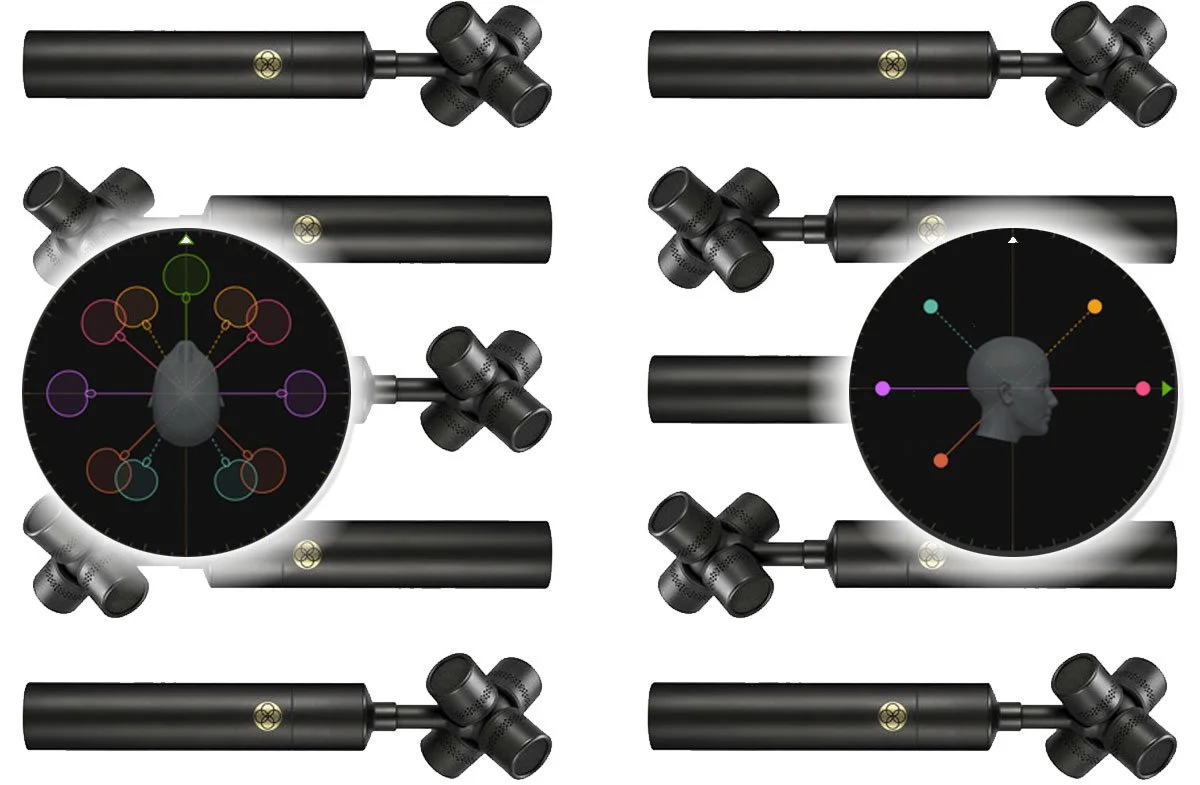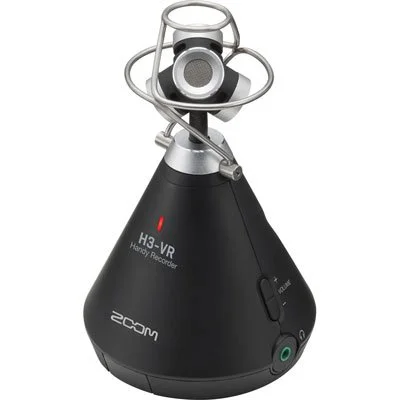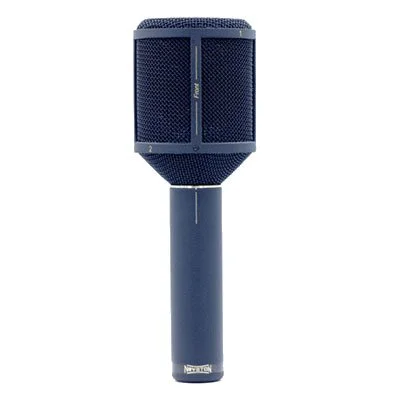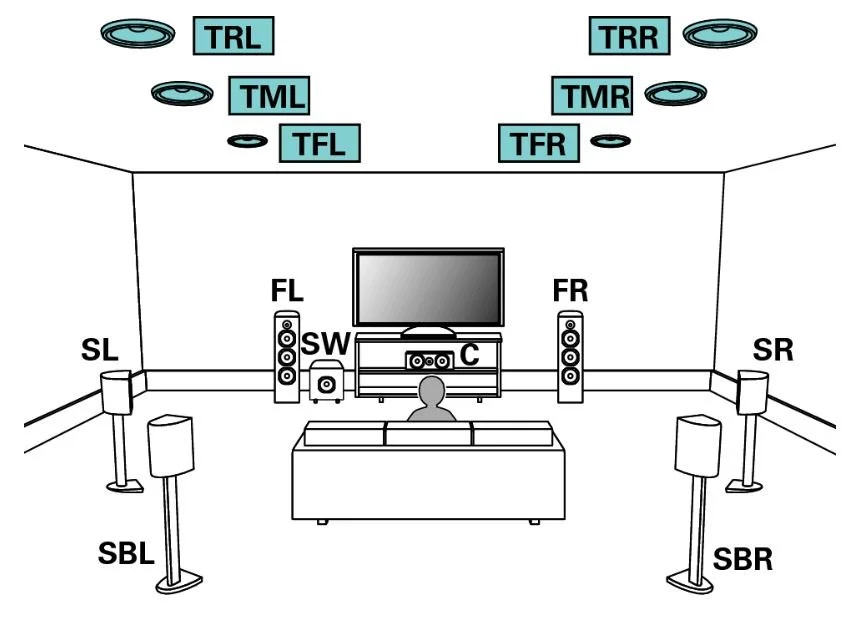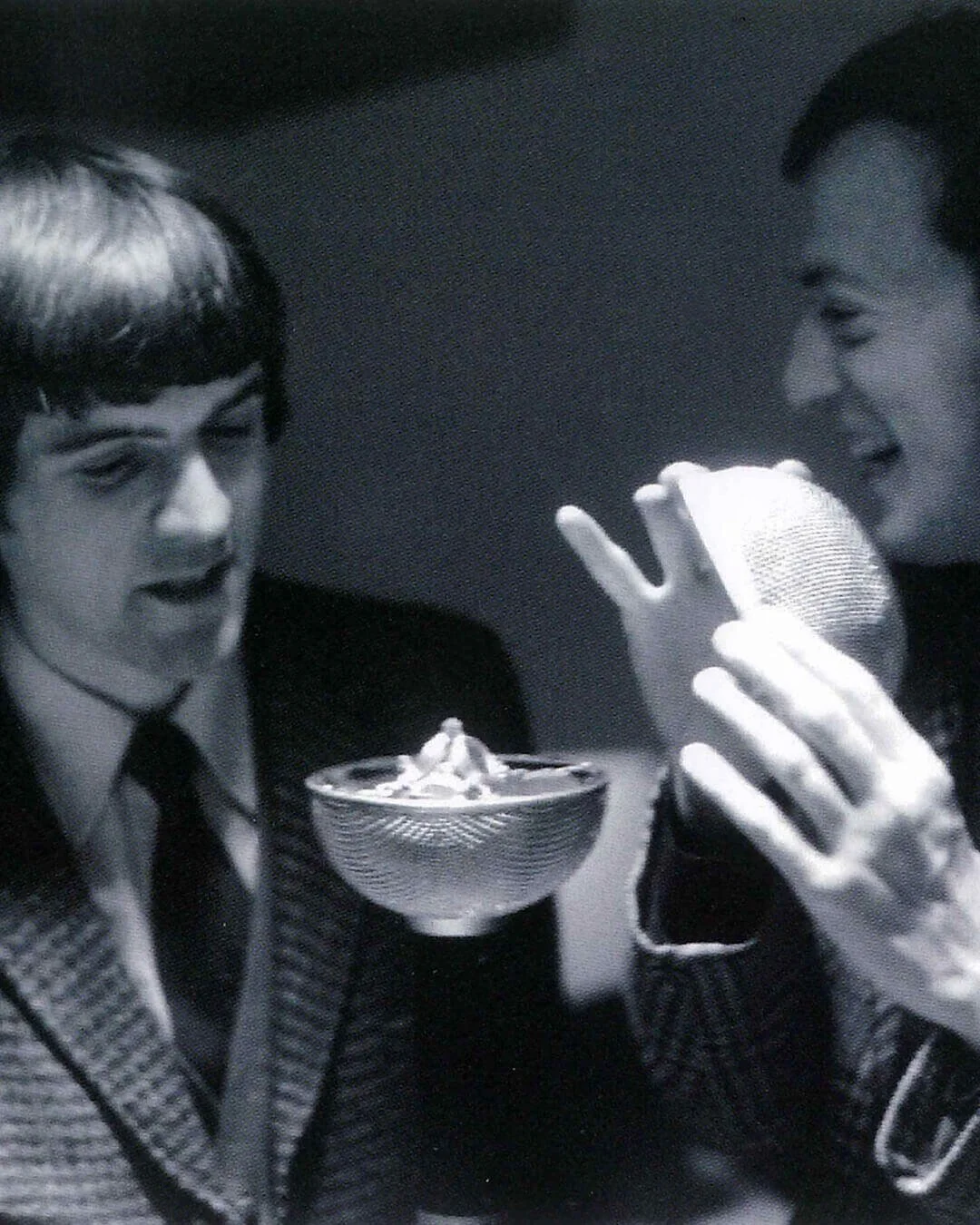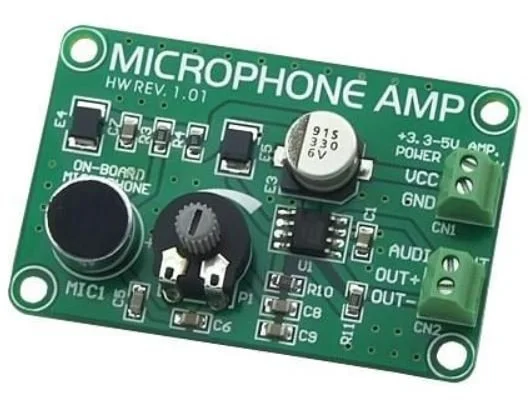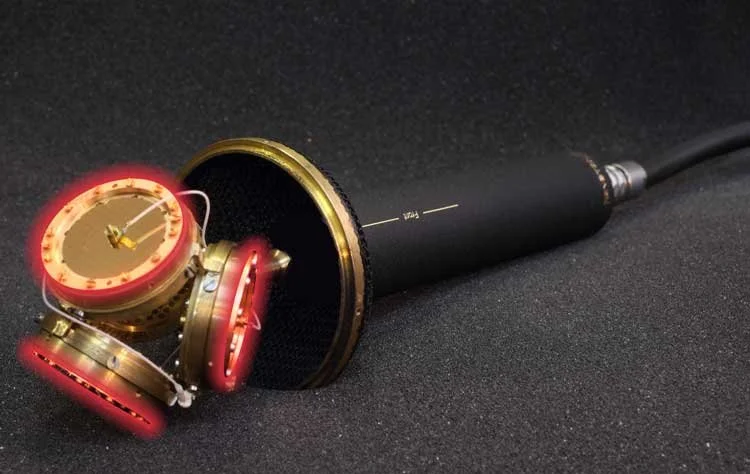Best Ambisonic Microphones (First-Order)
Everything you need to know about ambisonic microphones, file formats, and processing software.
Although invented back in the 1970s, ambisonic microphones have only become popular recently.
With the advances in VR technology and immersion becoming a major goal for film and video game designers, societal needs have finally caught up to ambisonic technology.
This post will examine the best, first-order ambisonic microphones on the market, as well as provide background information on all the important features, specifications, and work flows of ambisonic microphones and their associated files.
Recommended Ambisonic Microphones (Quick Links)
Best for Beginners
An all-in-one ambisonic microphone and recorder, the Zoom H3-VR is the best ambisonic microphone for beginners, no external processing required.
Learn More
Best for Enthusiasts
The Rode NT-SF1 is much lower noise than the Zoom H3-VR.
Designed specifically for the SoundField by Rode plugin, no calibration files are required for perfect A to B-format conversion.
Learn More
Best for Professionals
The Nevaton VR is the best ambisonic microphone money can buy.
With only 4 dB-A of self noise, internal heaters, pad and low-cut filters, and custom calibration files, there simply is no better option.
Learn More
What Is an Ambisonic Mic?
There are currently several surround sound systems, with Dolby being the industry standard.
In conventional Dolby 5.1 surround sound, there are 5 main speakers and 1 subwoofer. These speakers are arranged in a horizontal plane around the listener and surround them with audio from the front, front-right, front-left, rear-right, and rear-left. The low frequencies from the subwoofer are non-directional and fill the entire space.
Ambisonics are not confined to the horizontal plane. Ambisonics is a full-sphere surround sound technique that, in addition to the horizontal plane, captures sounds above and below the listener.
The addition of height information captured by ambisonic microphones has helped push the limits of what’s possible with surround sound.
Dolby now offers support for up to 13.1 surround sound with the following speaker locations:
13.1 surround sound speaker layout.
center
front-right & left
side-right & left
side-back-right & left
top-front-right & left
top-mid-right & left
top-rear-right & left
subwoofer
The ability to record environments with ambisonic microphones saves sound engineers a lot of time when mixing audio for film, and creates entirely new possibilities when used for virtual-reality (VR) gaming experiences.
Benefits of ambisonic microphones:
360° sphere of sound + height information
Captures surround sound with a small footprint
Can be manipulated in post production for almost any stereo format from binaural to 13. 1 surround sound
When Was Ambisonics Invented?
Pioneering legends, Peter Craven (left) and Michael Gerzon (right), with the first SoundField Microphone.
Developed by Michael Gerzon, Peter Felgett, and Geoffrey Barton in the early 1970s at the University of Oxford and the University of Surrey, ambisonics was way ahead of its time and did not become popular until very recently.
The delayed success of ambisonics was primarily due to:
virtually zero consumer products existed to experience ambisonics
limited marketable use of ambisonic audio (all media was still stereo)
massive data rates
Nowadays, immersive content is the goal of film and entertainment industries, and sound is arguably the most important and most convincing element in enveloping the viewer and transcending their disbelief.
Additionally, with the emergence of VR technology, ambisonic audio has perhaps finally met its true calling.
What is 1st, 2nd, 3rd Order Ambisonics?
Ambisonic orders refer to the total number of audio channels in an ambisonic array.
The greater the number of channels, the greater the resolution of the ambisonic recording.
Resolution is an important factor of ambisonic recordings. For lower order ambisonic arrays, some details may be lost when the sphere is rotated (when someone turns their head in a VR environment).
Higher order ambisonic arrays capture more data points within the sphere and can seamlessly create accurate sound localization no matter what direction the viewer is facing.
The formula for calculating the audio channels of a given order (ℓ) is as follows:
Full-sphere systems = ( ℓ + 1 ) ² signal components
Let’s calculate how many signal components (audio channels) are needed for first-order ambisonics.
The order in question is first, so ℓ = 1. Now the formula looks like this: ( 1 + 1 ) ²
From here, the rest is simple and we arrive at the answer 4. 4 audio channels are required for first-order ambisonics.
Below is a table listing the number of channels required for ambisonic orders up to 7.
It is worth noting that, at the time of this writing, the highest order ambisonic microphones currently available is third-order.
| Order | Channels |
|---|---|
| First | 4 |
| Second | 9 |
| Third | 16 |
| Fourth | 25 |
| Fifth | 36 |
| Sixth | 49 |
| Seventh | 64 |
Seventh-order ambisonic microphones are the highest order of ambisonics computers can support since plugins for digital audio workstations (DAWs) are limited to 64 input channels.
What is Ambisonics Used For?
Ambisonic microphones are used for recording fully immersive sonic environments.
The recordings are well-suited for 3 primary applications:
1. Surround Sound Applications - Ambisonic microphones quickly and easily capture coherent and immersive surround sound in an extremely small package, making wind protection a cinch.
After recording, the files can be decoded and used in surround sound applications including film, video game design, and VR experiences.
2. Flexibility In Post Production - Since ambisonic recordings are nearly infinitely adjustable in terms of creating virtual microphone patterns, they can be used for any project requiring sound; whether that be stereo, binaural, mid-side, double mid-side, or even quad.
This gives the sound designer limitless creativity as they can experiment with:
Change the microphone configuration - after the recording has taken place, you can change the microphone array to X-Y, spaced A-B pair, ORTF, mid-side, double mid-side, or quad.
Change the polar pattern - in post production, you can create virtual microphone patterns from the ambisonic files including omnidirectional, cardioid, sub-cardioid, and figure-8.
Change the microphone position - if the stereo image of your track is a little off, no problem. With ambisonic recordings, you can change the position, angle, and tilt of the microphone to suit your needs.
Change the number of microphones - besides creating virtual microphone patterns, you can also create virtual microphones to add to your mix. This is extremely helpful if your producer suddenly requires a surround sound mix.
3. Virtual Reality & 360° Video - 360° video and VR experiences are rapidly growing fields in gaming, virtual environments, and immersive video content.
Ambisonic audio allows for a fully head-tracked audio experience for hyper realism.
How To Process Ambisonic Audio
Before ambisonic recordings can be mixed in post production to reproduce sound in all directions, it must be converted into a format compatible with ambisonic plugins in your DAW of choice.
In this section you’ll learn about:
A-Format vs B-Format
A Format is the raw output from an Ambisonic microphone.
B Format is an interpretation of A Format, splitting the signals into representations of space: Y for standard left/ right, X for front or rear, Z for height, and W as an omnidirectional reference.
The raw, unprocessed audio files output from an ambisonic microphone are in what’s known as A-format.
A-format records the 4 audio channels as follows:
Front-Left-Up (FLU)
Front-Right-Down (FRD)
Back-Left-Down (BLD)
Back-Right-Up (BLU)
Alone, A-format is not very useful to audio engineers, as it cannot be used to create responsive sonic content.
Converting A-format to B-format mathematically combines the 4 A-format channels into 4 new channels named W, X, Y, and Z. The conversion calculations are as follows:
W = FLU+FRD+BLD+BRU
X = FLU+FRD-BLD-BRU
Y = FLU-FRD+BLD-BRU
Z = FLU-FRD-BLD+BRU
These 4 new signals are mathematically defined as the signals of 4 coincident microphones. W is a pressure microphone (omnidirectional), while X, Y, and Z are velocity microphones, having a directivity pattern resembling a figure-8.
The following image shows the directivity patterns for these microphones:
The B-Format signal can be easily manipulated to emulate any type of microphone and polarity – omni, cardioid, sub-cardioid, directional etc. You can then point these ‘virtual’ microphones any direction you choose – to the right and left, to the rear, and even up and down.
How To Convert From A-Format to B-Format
Converting from A-format to B-format ambisonics is an easy process made possible by readily available (and free) software.
Most ambisonic microphones come with conversion software that can be used in almost any DAW.
If yours did not include conversion software, no problem, there are great options available to choose from.
There are 2 types of B-format, so it’s important to know their differences and which one is required for your project before converting.
FuMa (Furse-Malham) - Older standard that is still supported by a variety of plug-ins and other ambisonic processing tools.
AmbiX - Modern standard that has been widely adopted by distribution platforms such as YouTube.
FuMA channels are ordered as W-X-Y-Z, whereas AmbiX channels are ordered as W-Y-Z-X.
Ambisonic Converter Plugins
1. SoundField by Rode (FREE)
The SoundField by Rode ambisonic plugin is, in my opinion, the most user-friendly and intuitive interface for ambisonic format conversion, mixing, and exporting.
Features:
A-format to B-format conversion
Intuitive user interface
Ability to change all virtual microphones’ polar patterns (omni, cardioid, figure-8, shotgun)
Surround sound mixing
Output for all common surround sound formats + custom speaker configurations
Specifications:
|
Input Format |
A-Format, B-Format (FuMa), B-Format (AmbiX) |
| Output Format | B-Format (FuMa), B-Format (AmbiX), Mono, Stereo, 5.1, 7.1, 7.1.2, 5.1.4, 7.1.4 |
| OS Requirements | Windows 10, macOS 10.11 or higher |
| Plugin Type | VST, AAX, Audio Units |
| Supported Host Applications | Protools 12.8, Cubase 9, Nuendo 8, Reaper 5, Logic Pro X 10.4, Final Cut Pro X 10.4 |
2. Sennheiser AMBEO A-B Converter (FREE)
The Sennheiser AMBEO ambisonic plugin does not have as many features as the SoundField by Rode plugin, but is still a great piece of free ambisonic software if you simply need to convert to B-format.
The Sennheiser AMBEO plugin does not support changing virtual microphone polar patterns, or output to any formats besides FuMa or AmbiX B-format.
Features:
A-format to B-format conversion
Intuitive user interface
Ability to rotate virtual microphones
Specifications:
|
Input Format |
A-Format |
| Output Format | B-Format (FuMa), B-Format (AmbiX) |
| OS Requirements | Windows 8.1 or higher, macOS 10.10 or higher |
| Plugin Type | VST, AAX |
| Supported Host Applications | Not Listed |
3. VVEncode (PAID)
VVEncode is a very simplified ambisonic converter plugin with no bells or whistles.
However, it is one of the only ambisonic converters that accepts custom calibration files for the most accurate conversions from A to B-format for your specific ambisonic microphone.
Most manufactures will include calibration files with purchase. If your ambisonic microphone did not include calibration files, please browse the excellent work of Professor Angelo Farina here.
Professor Angelo Farina has graciously researched and provided calibration files for most ambisonic microphones on the market for free download.
I recommend trying the SoundField by Rode plugin first, and if you are unhappy with the frequency range and imaging of the conversion, use VVEncode with a custom calibration file for your microphone.
Then, export to B-format and use the converted file in the SoundField by Rode plugin for advanced mixing and output for surround.
How To Choose an Ambisonic Mic
Before selecting an ambisonic microphone, it’s important that you have a thorough understanding of the following specifications and features of ambisonic microphones:
Self Noise
Microphones and their associated preamplifiers both have inherent levels of noise.
The noise is created by electrons moving in circuits and sounds like the classic white-noise static hiss.
The problem with self noise is that too much of it can ruin a recording. When using a microphone or preamplifier with high self noise, the hissing sound can overpower your subject. At best, this can be distracting, and at worst, unbearable.
All microphones and preamps produce some amount of self noise, but the amount varies between devices and you usually get what you pay for.
Depending on the components used in construction like tubes, transistors, resistors, and the layout of the PCB, the self noise of a device can be minimized. Finding, combining and designing the lowest self noise components and layouts requires significant research and development, hence the increased price for low noise products.
So how much self-noise is too much?
Well, it depends on what you’re recording. If you’re recording loud sounds, your subject will easily overpower the noise from the recorder and it won’t be audible in the final recording. However, self noise can be a major problem when attempting to record quiet sounds.
Self noise usually becomes an issue when attempting to record sounds less than 40dB. In order to determine how quiet your sounds are, please use the image below.
If you don’t know how loud your sounds are, I recommend using an app on your phone to measure them. My favorite is the Decibel app by Vlad Polyanskiy (iOS / Android).
As a nature field recordist, the sounds I record are between 20-40 decibels so I need extremely quiet recording equipment to capture those sounds without any background hiss.
So what is a good self noise value for recording quiet sounds?
Self noise can be challenging to understand and compare between recorders due to the number of ways it’s measured. Some manufacturers don’t even include a self noise measurement under the specifications!
While researching microphones and recorders you may see self noise measured as:
Self Noise: measured in dBA
Equivalent Input Noise (EIN): measured in dBu
Signal-To-Noise Ratio (SNR): measured in dB
Use the chart below to determine what an acceptable self noise measurement is for your use.
| Self Noise (dBA) | EIN (dBu) | SNR (dB) | Rating | Description |
|---|---|---|---|---|
| ≤ 12 |
-130 | ≥ 82 |
Ultra Quiet | Extremely low self noise. Undetectable even under the most critical recording conditions. |
| 16-13 | -126 | 78-81 | Very Good | Very slight noise discernable when recording the quietest signals. |
| 20-17 | -119 | 74-77 | Good | Good enough for most purposes. Noise noticeable in quieter recordings. |
| 24-21 | -110 | 70-73 | Fair | Noise obvious when recording anything below speaking level. |
| ≥ 24 |
-100 | ≤ 69 |
Poor | Not recommended unless you only record waterfalls, alarms and jets (very loud signals). |
Ambisonic Formats
As previously mentioned in the A vs B-format section, most ambisonic microphones record in A-format, which requires conversion to B-format to unlock the full creative potential of ambisonic recordings.
However, some ambisonic microphones, like the Zoom H3-VR, natively record in B-format.
This eliminates the need for external processing on a computer, and is a major time-saver if you simply want to enjoy your ambisonic recordings on a set of surround sound speakers.
Internal Heaters
For capturing ambisonic recordings outdoors, I highly recommend purchasing an ambisonic microphone with internal heaters.
When turned on, the heaters will prevent any moisture from condensing on the microphone capsules, that would cause unwanted pops, burps, and crackling sounds otherwise.
If you plan on recording outdoor soundscapes where humidity is historically below 70%, internal heaters are not required. However, if you plan to leave your ambisonic microphone out overnight, you’ll still benefit from internal heaters, that will prevent your microphone from succumbing to unwanted distortion caused by morning dew.
Best Ambisonic Microphones
After thoroughly researching the market for first-order ambisonic microphones, I’ve come up with the following ambisonic microphone recommendations:
Each recommendation features my professional opinion, recommended use, and important specifications that will help you make the best decision for your specific needs.
If you do choose to purchase an ambisonic microphone, please do so through the links on this page. At no extra cost to you, I’ll earn a small commission payment ☺
Best Ambisonic Mic For Beginners
Zoom H3-VR
The Zoom H3-VR is the perfect ambisonic microphone for beginners interested in experimenting with ambisonic formats.
Besides being the most affordable ambisonic mic on the market, the H3-VR is an all-in-one ambisonic microphone and recorder that natively generates B-format ambisonic files, thus eliminating the need for external processing and external recording devices.
This simplified workflow makes ambisonics more approachable while still providing the option for advanced processing, mixing, and output to surround sound formats.
Accessories:
Foam Windscreen
Bracket for Camera Mounting
Specifications:
| Capsule Arrangement | Tetrahedral |
| Self Noise | Not Provided |
| Sensitivity | Not Provided |
| Recording Format | A-Format, B-Format (FuMa/AmbiX), Stereo, Binaural |
| Internal Heaters | No |
Best Ambisonic Mic for Enthusiasts
Rode SoundField NT-SF1
The NT-SF1 is a great ambisonic microphone for enthusiasts looking for a quieter ambisonic mic than the Zoom H3-VR.
With only 15 dB-A of self noise, the NT-SF1 is capable of recording ambisonic soundscapes with very little background hiss.
This is the microphone the SoundField by Rode ambisonics plugin was created for, and will yield perfect conversions to B-format without the need for calibration files.
Additionally, the NT-SF1 includes some great accessories:
Suspension Shockmount
Blimp Windshield
Furry Windcover
XLR Breakout Cable
Specifications:
| Capsule Arrangement | Tetrahedral |
| Self Noise | 15 dB-A |
| Sensitivity | -30.4 dBV |
| Recording Format | A-Format |
| Internal Heaters | No |
Best Ambisonic Mic for Professionals
Nevaton VR
The Nevaton VR is the best ambisonic microphone money can buy.
With incredibly low noise of 4 dB-A, internal heaters, switchable low-pass filter and attenuation pad, and ability to handle extremely high SPL levels, there simply is no better ambisonic mic available.
The Nevaton VR is the best choice for recording outdoor ambisonic soundscapes, as it is one of only two ambisonic microphones with internal heaters. The other option is the SoundField ST450, but at a cost of almost $10,000 and with 13 dB-A of self noise, it pales in comparison to the Nevaton VR.
Accessories:
Metal Mesh Grill - protects exposed capsules from physical damage and wind noise
3 m 10pin → 4 XLR3 cable
Custom Calibration Files
Wooden Carrying Case
Specifications:
| Capsule Arrangement | Tetrahedral |
| Self Noise | 4 dB-A |
| Sensitivity | -34 dBV |
| Recording Format | A-Format |
| Internal Heaters | Yes |
Support Acoustic Nature
If you enjoyed this post and would like to help support Acoustic Nature, please consider "buying me a coffee" or becoming a Patreon with the buttons below.
As a thank you for your support, Patreon supporters receive a copy of Field Recording For Beginners, exclusive access to the full Behind The Sounds video series, nature sound library downloads, and more.
If you are unable to support the site financially, please share this post with others, or leave a comment below letting me know you enjoyed this post! Both are free and help the website grow. Thank you ♫
Thanks for reading,
-Jared

